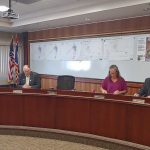News – Sheridan Media
[[{“value”:”
In part one this column talked about Sacajawea and her contribution to the Lewis and Clark Corps of Discovery Expedition.
Sacajawea when with the Corps to the ‘Big Water’ as she called the Pacific Ocean, and she then returned to the Mandan Village in present day North Dakota. However, she was not happy there and returned to her tribe in Wyoming. Although there have been controversies about where she died and where she is buried, the most historians agree that she is buried in the Sacajawea cemetery at Fort Washakie, Wyoming.
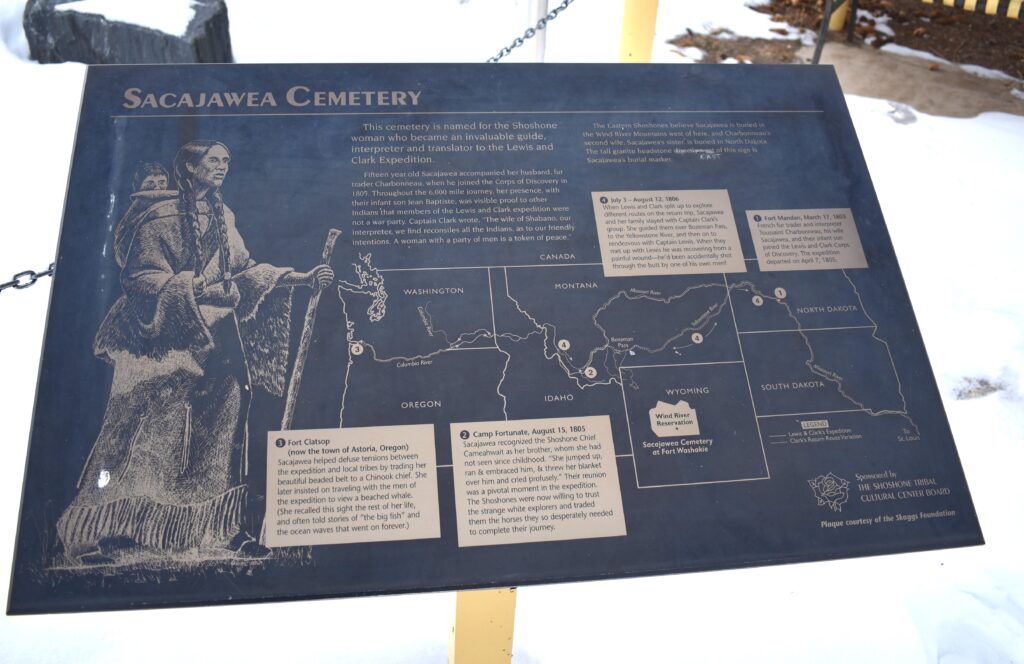
The Big Horn County Rustler, February 20, 1920 – Sacajawea and Her Two Sons – Over her grave at Wind River is a stone marking the last resting place Of Sacajawea, “the Bird Woman.” This stone bears a tablet setting forth that credit is due to Dr. John Roberts missionary at the Agency, for having discovered Sacajawea after she had gone from the Mandan village into the Wind River country. Dr. Roberta says that to Hon. Jas. J. Patten belongs most of the credit for having made the discovery. It is quite apparent that each of those gentlemen is very modest regarding the matter. However, the following information regarding Sacajawea and her two sons, prepared by Mr. Patten, will make interesting reading:
Sacajawea – After Lewis and Clark’s expedition returned to the Mandan village on the Missouri. Sacajawea and Touissant Charborneau parted with the expedition members. Charboneau, as the cook, received the sum of five hundred dollars as his salary, but she, next in importance to tho leaders of the expedition, was not considered in the list of employees, for reasons not known. At any rate she received no stipend; not one cent for her valuable and important service.
Thus Lewis and Clark returned to the east, the famous woman in her captive home. It will be remembered that the leaders of the expedition at every point where the different tribes at war with each other could be assembled were called into council where Captain Lewis addressed them on the subject of peace between them, and which was invariably agreed to and in some cases the peace agreement held good for several years. So it was with the Mandans.
However, after her return from the coast and after meeting her people on the Madison on the trip out, Sacajawea was not satisfied to remain among her Mandan and Minnetaree friends and was constantly planning to get away and return to her own people the Shoshones. Several years of comparative peace existing among the Indians at that time, thus, the opportunity came to Sacajawea to withdraw or escape. She with her husband wandered back on to the Snake river, where she met and ever after remained with the Shoshone. Charboneau, her husband, shortly after their arrival, died at White Rocks, Utah
I can remember Sacajawea’s personal appearance but very dimly, as it was a good many years ago that I first saw her. She was with Bazil one day when the Indians were drawing their weekly rations at the agency warehouse. Bazil and I were walking together towards where the Indians were and when we had passed into the yard, we say an aged Shoshone woman lying on her back, her shoulders resting on a fifty-pound sack of flour, around which was looped a strap or rope, the end of which were brought over her shoulders and held in her hand in front. She was just ready to rise with her burden and Bazil assisted her to her feet and she trudged off and I told Bazil I thought the load too heavy for such an old person to carry. “See. She is staggering, she is quite old and weak.”
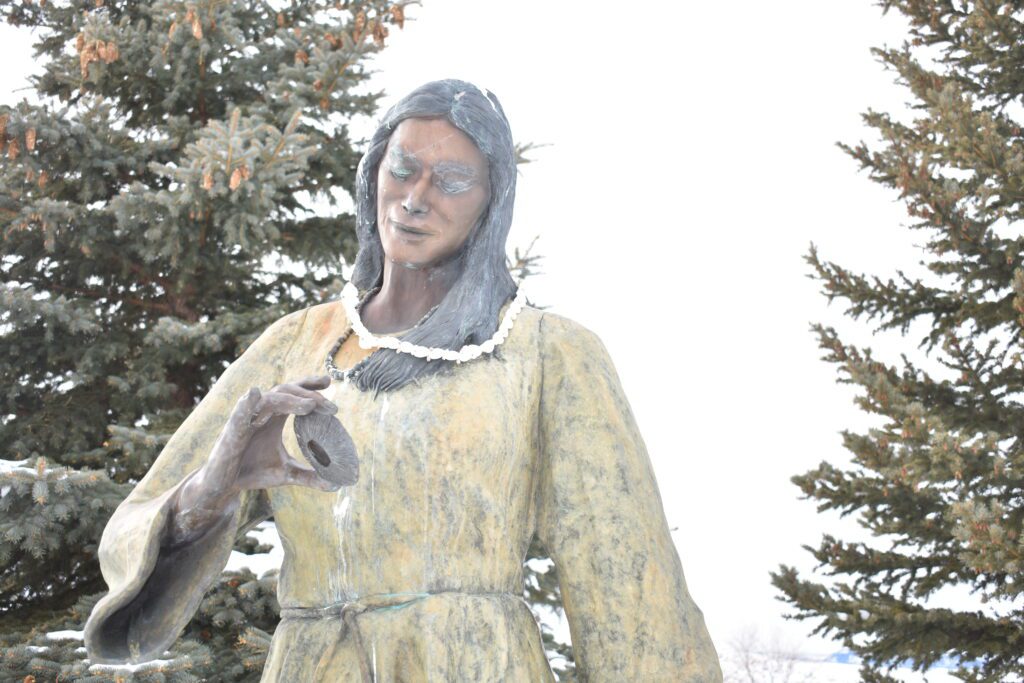
Statue at the Sacajawea cemetery at Fort Washakie, Wyoming.
Bazil replied, “Yes, pretty old. She is my mother, he said, and mentioned Lewis and Clark. This was my first sight of her and under the circumstances not very distinct. However, I gained a glimpse of her poor wrinkled face which in young life must have been very fair. Her eyes I could not see, her features were regular and her height was not over five feet and of good form. The second time I saw her was on the day we were preparing to take the trip into the Basin country in 1874, when Bazil brought her up and gave her over to the care of Agent Irwin while the hunt lasted. She was then too infirm to walk and lay in her small tent all the time.
Battez – This Shoshone sub-chief was supposed to be the son born to Sacajawea shortly after the arrival of the expedition at Mandan. He died at the agency several years; ago. He did not speak French. He was a man of little force or importance in the tribe, about five feet six inches in height, quite dark complexion. Stocky built, weight about two hundred pounds, thick lips and his mouth drawn well down at the corners, was rather pleasant and sociable in manner, liked ease and enjoyed it, had a wife and several children. He acknowledge Sacajawea as his mother and that she accompanied the expedition to the coast, but seemed to take but a passing interest in her.
Bazil – Bazil was also a sub-chief of the Shoshone tribe and usually quite active in tribal affairs. He was rather lighter in complexion than Battez. He was lame in one of his limbs, five feet eight inches in height, weight about two hundred seventy-five pounds, thick lips., very pleasant and good natured in manner. He also claimed Sacajawea as his mother gave to her always all the attention and care that a son would be expected to show to a mother. It was a question never definitely settled at the Agency, which one it was who was born at the Mandan village or whether their father was the same, but according to the most reliable information obtained, Bazil being the oldest, it was thought must have been Touissant. He spoke French fluently.
This must have been a different spelling of Baptiste
Bazil, too, died and was buried at the Agency seven or eight years ago. The death of these two being the last of the generation who knew much of Sacajawea’s history, further facts it is impossible to secure. All regret this and none more so than the Rev. Mr. Roberts and your humble servant When I knew her she was old and decrepit, so that I never held a conversation with her, and until the time of her death, Mr. Roberts knew nothing of her fame or of the important expedition of which she was so conspicuous a member.
“Their works do follow them.”
William Clark was taken with the boy, and for a time Baptiste lived in St. Louis and Clark paid for his education at the St. Louis Academy, a Jesuit Catholic school. He also named the notable landmark, Pompey’s Pillar, after the boy, whom he nicknamed Pomp or Pompey.
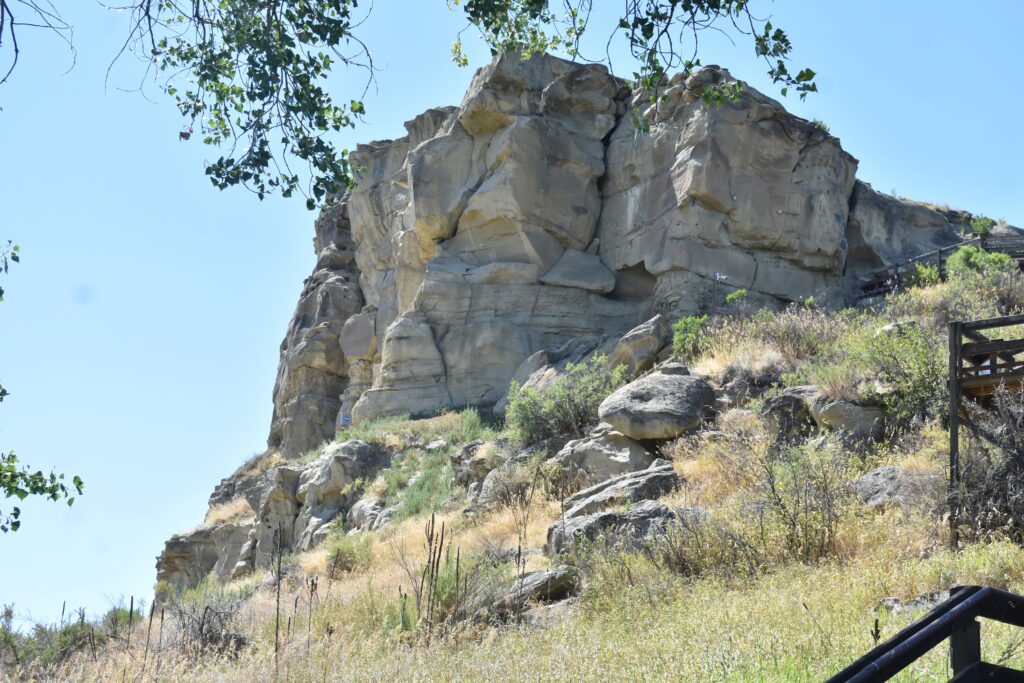
The Sheridan Post, November 14, 1905 – Cheyenne Tribune. Sacajawea’s Grave Basin, Wyo., Nov. 11. – The mystery surrounding the location of the grave of Sacajawea, the Shoshone Indian maid who acted as a guide for Lewis and Clark on their historic journey across the western country to the Pacific Coast, has been solved by James I. Patten, a Wyoming pioneer who resides in this city.
Patten came to Wyoming nearly forty years ago, and when he first reached the Shoshone Indian agency in 1871 states that Sacajawea was then living with her people on the Wind River reserve. Her tribal name was “Wadzewipe, meaning”the last woman,” she having been captured by a band of hostile Indians and heldby them until she met and married the Frenchman who acted as cook for Lewis and Clark.
Sacajawea died at the Shoshone agency on April 9, 1884, and was buried there on the Indian cemetery near the old mission, which still stands. RevJohn Roberts, is in charge, of the mission. “I met and became well acquainted with Baptist, the son of Sacajawea.” said Mr, Patten, “and he often spoke of his mother’s trip to the Pacific coast.
This next following excerpt is a part of a much longer story, from the Powell Tribune, September 15, 1916, which mainly deals with the many memorials that have been created to honor this brave woman. There are more statues of her than of any other American Woman. One stands in Washington, D.C., one in Bismark, ND, one in Portland, Oregon, and many places along the Lewis and Clark historic trail.
And, of course, over her grave in Fort Washakie, Wyoming.
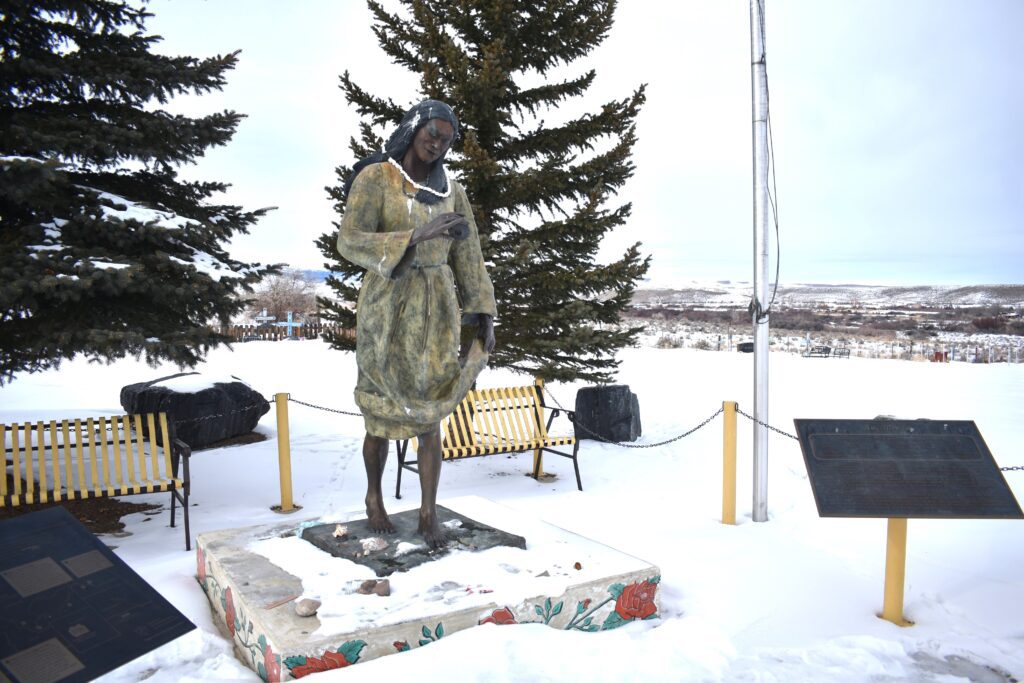
Statue in the Sacajawea Cemetery, Ft. Washakie, Wyoming note the seashells around her feet and in her hand.
Wyoming State Tribune, Cheyenne State Leader, December 25, 1923
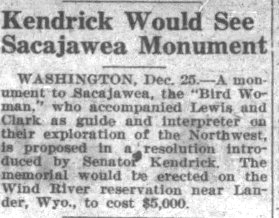
Powell Tribune, September 15, 1916 – When she became old and feeble Sacajawea returned to her own people. the Shoshones, who were in the habit of roving from Idaho to Wyoming. In the neighborhood of Bridger’s fort, in the ’30’s and ’40’s, young Charboneau. Sacajawea’s son was a well known guide to Wyeth, Bonneville, Fremont and others and is mentioned in several overland journals of that period.
Captain William Clark Kennerly of St. Louis, a nephew of Captain Clark of the expedition told Mrs. Dye when she was writing “The Conquest.” that he and Jefferson K. Clark out on a hunting trip, met Sacajawea’s son at Bridger’s fort in 1842 and knew he was the identical boy educated by Governor Clark in St. Louis.
One incident not mentioned by Mrs. Dye in”The Conquest” proves an especial confirmation: When Sacajawea met her brother Chief Cameahwait, on the great expedition, the Lewis and Clark journals say that Sacajawea’s sister had died and left a child. This boy about two years old, Sacajawea immediately adopted. So there were two children with her on the trip to Oregon; and these two remained ever with her, one pure Indian and her own part white. Their children and grand children are now living on the Shoshone reservation in Wyoming.
While Sacajawea was known as the Bird-Woman in Dakota, probably because her captors were the Crow or Bird Indians, from whom she was purchased. In Wyoming she was Sacajawea, the Boat-Pusher. She was also called by old Shoshones Wadze-wlp, the Lost Woman. For many years officials of the agency had known the story of Sacajawea; she often told of the journey with “the first white men” to the “Big Water,” and kept the Jefferson medal given by Lewis and Clark to her husband Charboneau.
Sacajawea was a brave, resourceful woman, and should be added to the list of Wyoming Firsts, as she was undoubtedly the first woman guide on the Western Frontier.
Feature image of Sacajawea and Baptiste taken at the Pompey Pillar Interpretive Center in Montana.
“}]]
Last modified: November 23, 2024





